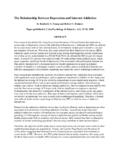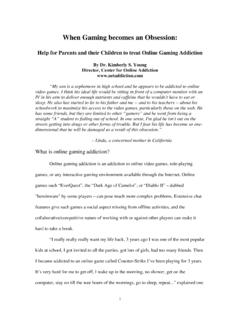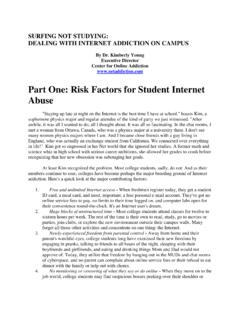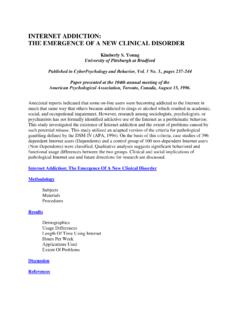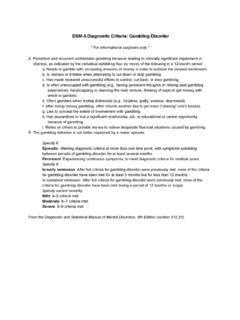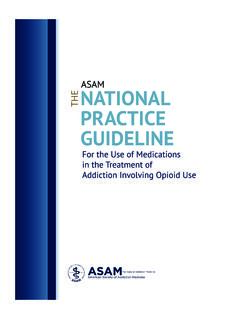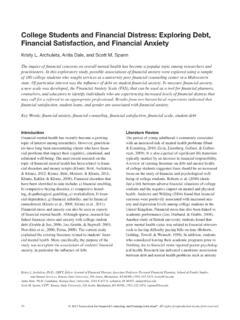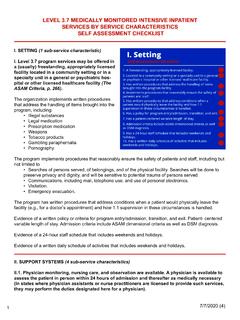Transcription of Internet Addiction: Symptoms, Evaluation, And Treatment
1 Internet Addiction: Symptoms, Evaluation, And Treatment Dr. Kimberly S. Young This article is reproduced from Innovations in Clinical Practice (Volume 17) by L. VandeCreek & T. L. Jackson (Eds.), Sarasota, FL: Professional Resource Press. Copyright 1999 by Professional Resource Exchange, Inc. and reprinted with permission. Further electronic/printed circulation or duplication is strictly prohibited without explicit written authorization from Professional Resource Exchange, Inc. SUMMARY The Internet itself is a neutral device originally designed to facilitate research among academic and military agencies.
2 How some people have come to use this medium, however, has created a stir among the mental health community by great discussion of Internet addiction. Addictive use of the Internet is a new phenomenon which many practitioners are unaware of and subsequently unprepared to treat. Some therapists are unfamiliar with the Internet , making its seduction difficult to understand. O ther tim es, its im pact on the individual s life is m inim ized. T he purpose of this chapter is to enable clinicians to better detect and treat Internet addiction.
3 The chapter will first focus on the complications of diagnosis of Internet addiction. Second, the negative consequences of such Internet abuse are explored. Third, how to properly assess and identify triggers causing the onset of pathological Internet use are discussed. Fourth, a number of recovery strategies are presented. Lastly, since Internet addiction is an emergent disorder, implications for future practice are presented. Complications In Diagnosing Internet Addiction Negative Consequences Of Addictive Use Of The Internet Familial Problems Academic Problems Occupational Problems Assessment Of Pathological Internet Use Applications Emotions Cognitions Life Events Treatment Strategies For Pathological Internet Use Practice The Opposite External Stoppers Setting Goals Abstinence Reminder Cards Personal Inventory Support Groups Family Therapy Future Implications Of Pathological Internet Use
4 References COMPLICATIONS IN DIAGNOSING Internet ADDICTION Notions of technological addictions (Griffiths, 1996) and computer addiction (Shotton, 1991) have previously been studied in England. However, when the concept of Internet addiction was first introduced in a pioneer study by Young (1996), it sparked a controversial debate by both clinicians and academicians. Part of this controversy revolved around the contention that only physical substances ingested into the body could be termed "addictive." While many believed the term addiction should be applied only to cases involving the ingestion of a drug ( , Rachlin, 1990; Walker, 1989), defining addiction has moved beyond this to include a number of behaviors which do not involve an intoxicant such as compulsive gambling (Griffiths, 1990), video game playing (Keepers, 1990), overeating (Lesuire & Bloome, 1993), exercise (Morgan, 1979), love relationships (Peele & Brody, 1975), and television-viewing (Winn, 1983).
5 Therefore, linking the term "addiction" solely to drugs creates an artificial distinction that strips the usage of the term for a similar condition when drugs are not involved (Alexander & Scheweighofer, 1988). The other controversial element related to the use of the Internet addiction is that unlike chemical dependency, the Internet offers several direct benefits as a technological advancement in our society and not a device to be criticized as "addictive" (Levy, 1996). The Internet allows a user a range of practical applications such as the ability to conduct research, to perform business transactions, to access international libraries, or to make vacation plans.
6 Furthermore, several books have been written which outline the psychological as well as functional benefits of Internet use in our daily lives (Rheingold, 1993; Turkle, 1995). In comparison, substance dependence is not an integral aspect of our professional practice nor does it offer a direct benefit for its routine usage. In general, the Internet is a highly promoted technological tool making detection and diagnosis of addiction difficult. Therefore, it is essential that the skilled clinician understand the characteristics which differentiate normal from pathological Internet use.
7 Proper diagnosis is often complicated by the fact that there is currently no accepted set of criteria for addiction much less Internet addiction listed in the Diagnostic and Statistical Manual of Mental disorders - Fourth Edition (DSM-IV; American Psychiatric Association, 1995). Of all the diagnoses referenced in the DSM-IV, Pathological gambling was viewed as most akin to the pathological nature of Internet use. By using Pathological gambling as a model, Internet addiction can be defined as an impulse-control disorder which does not involve an intoxicant.
8 Therefore, Young (1996) developed a brief eight-item questionnaire which modified criteria for pathological gambling to provide a screening instrument for addictive Internet use: 1. Do you feel preoccupied with the Internet (think about previous on-line activity or anticipate next on-line session)? 2. Do you feel the need to use the Internet with increasing amounts of time in order to achieve satisfaction? 3. Have you repeatedly made unsuccessful efforts to control, cut back, or stop Internet use? 4. Do you feel restless, moody, depressed, or irritable when attempting to cut down or stop Internet use?
9 5. Do you stay on-line longer than originally intended? 6. Have you jeopardized or risked the loss of significant relationship, job, educational or career opportunity because of the Internet ? 7. Have you lied to family members, therapist, or others to conceal the extent of involvement with the Internet ? 8. Do you uses the Internet as a way of escaping from problems or of relieving a dysphoric mood ( , feelings of helplessness, guilt, anxiety, depression)? Patients were considered "addicted" when answering "yes" to five (or more) of the questions and when their behavior could not be better accounted for by a Manic Episode.
10 Young (1996) stated that the cut off score of "five" was consistent with the number of criteria used for Pathological gambling and was seen as an adequate number of criteria to differentiate normal from pathological addictive Internet use. I should note that while this scale provides a workable measure of Internet addiction, further study is needed to determine its construct validity and clinical utility. I should also note that a patient s denial of addictive use is likely to be reinforced due to the encouraged practice of utilizing the Internet for academic or employment related tasks.
